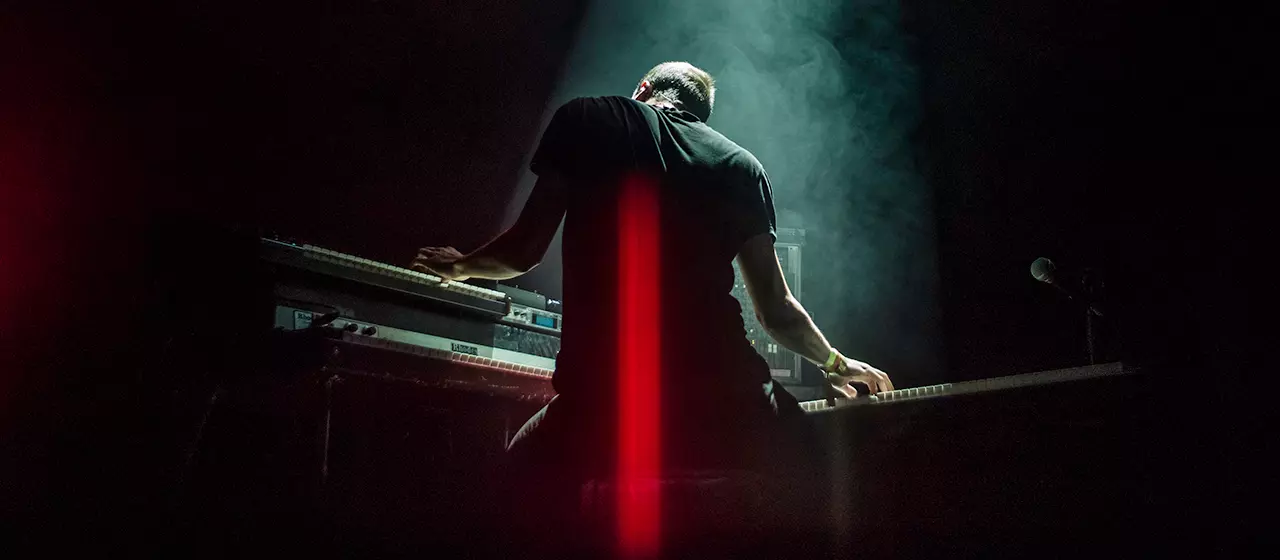There’s a real dichotomy to the German composer Martin Kohlstedt, one that can be felt through the ambivalence of his music. On the one side there is a very rational Martin, a pragmatic producer who has taken every element of his releases under his control. A musician who composes modularly, as if he were programming or coding his sensibilities. On the other hand, we have Martin’s right-side-of the-brain. Fingers which roam the piano freely in child-like creativity, an authenticity that often shines through in Martin’s expression when – eyes shut, mouth wide open – he plays live. This dichotomy is also conveyed in the opposing directions his music can take – sometimes reaching inward, or backward, as if Martin was turning deep into himself searching for some last remaining fragments of his childhood, and sometimes it expands outwards in a far-reaching movement through new forms of expression, new tools, that allow him to reach new heights. Somewhere in the midst of these opposing forces, sits Martin - not comfortably, but rather uncomfortably – in a tireless tug-of-war, harnessing the power of tensions and doubts.
Martin’s last couple of releases undeniably give in to his more rational, expansive side. STRÖME saw the composer work with Leipzig‘s 50-person Gewandhaus Chor in an ambitious experiment that combined singing, piano, and electronics. Immediately after, he launched RECURRENTS, inviting renowned musicians to rework the tracks on STRÖME. If collaboration and innovation were his guiding principles back then, spring 2020 turned things around quickly as Martin, and so many of us, faced the isolation and introspection brought about by a global pandemic. “I was making so much in the outer world, there was so much discourse, big concerts, a choir... it was important to talk to myself again. The lockdown was very personal, it forced me to search and find something,” says Martin. Confined in his Weimar apartment with nothing but his piano, Martin started working on FLUR, a solo piano album composed and recorded in the intimacy of his home.
In FLUR’s case, we say ‘composed’ for lack of a better word. As Martin explains, there was less composition going on and more of a ‘letting go’ and waiting for ideas to surface. “There was something inside me waiting to come out. I thought I was empty, but there was so much inside of me waiting to come out,” he says. While confinement set the perfect conditions for his exploration, Martin’s achievement with FLUR is anything but restrictive. A feeling of openness is exactly what connects the album’s tracks which are as structured as they are improvised, as uplifting as they are melancholic. Rather than forcing listeners to choose between any given state, this music makes space for, it allows, the formulation of new answers. And that’s exactly Martin’s aim with FLUR, to lift the restrictive boundaries of rational convictions, certainty and confidence, and make space for ambiguity, ”For me it’s very important to have doubt, not being entirely sure what you mean. One day you know it, and the next you no longer do,” says the pianist, “It’s about the contrasts – the thing in between is the most important.”
The album’s title is a play on this newfound navigation system through uncertainty. A specific forestry term, FLUR, is a corridor created through woodlands that’s critical for the maintenance of ecological processes including the movement of animals. It’s a path that’s as built and structured as it is instinctive and natural. Under lockdown, and unable to ask others for validation, Martin had to create his own path, “I had to value all the pieces myself, rather than the people around me. Where does the piece end? Where does it start? How long can you think about a particular thing?” says Martin “I needed to listen to my music, in the beginning it’s not easy. You hate every song like a child, you don't want to feel good with them, but you have to learn how to. You grow up in the recording process. You cannot hide.”
The album’s track PAN perfectly represents this state of emotional honesty. There’s an intimacy to the soft sounds of pedals that remind us of the man - Martin - behind the melody. The track’s strength is clearly its vulnerability, “This piece was just there. It’s a perfect symbol for the whole album. I never composed it before, it was just there,” says Martin. XEO on the other hand, is hard-hitting on an entirely different level. It’s an inquiry, an exploration that runs through several moods like a stream traversing different landscapes. It dictates its own direction and doesn’t look back, “XEO doesn’t come back to its starting point. It’s the door you choose, the option you take, the corridor. It has a braveness and courage to stay different,” explains Martin.
For those who have followed Martin Kohlstedt’s work, FLUR will feel like a breaking point from his last releases. All the structures he has built and refined over the years – avant- garde arrangements and complex experimental systems - simply collapse. Post-production and polishing seem to dissolve too. What’s left, however, is fundamental. Closer to his first albums TAG and NACHT It’s still not a return to his roots. With FLUR, Martin has created a new vocabulary and a fertile ground to build something anew. The album’s track JUL gives listeners some hints as to what that may be. The track, an epilogue of sorts closing off this particular journey, is also open-ended and filled with optimism. It’s an exciting prelude for what might be coming next, “this is the start of something for me,” says Martin.
